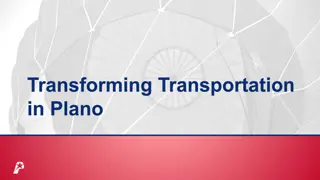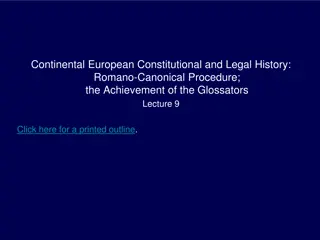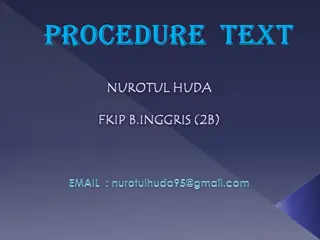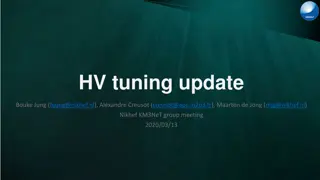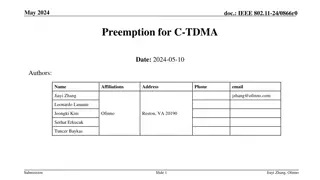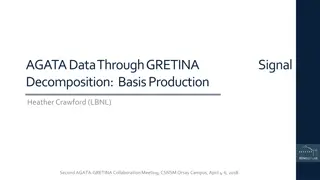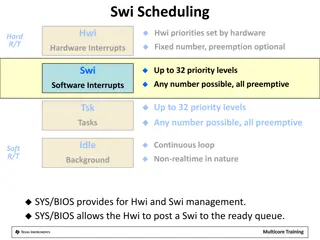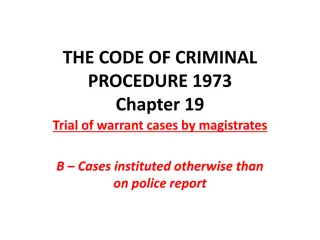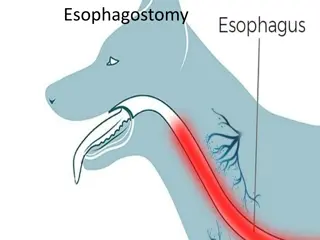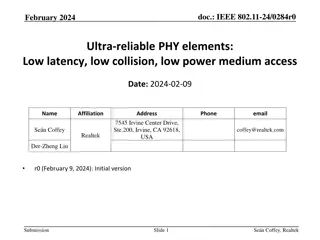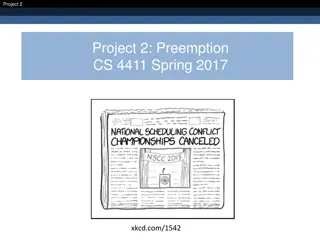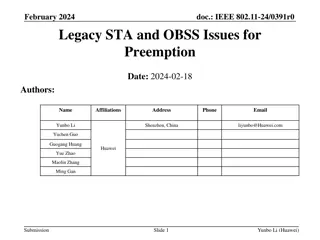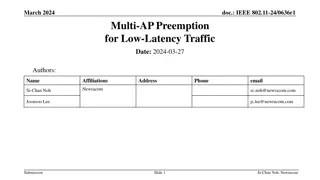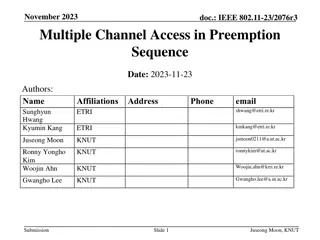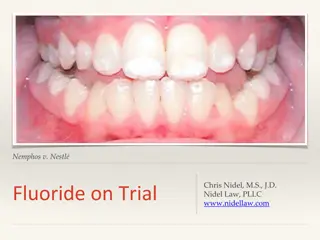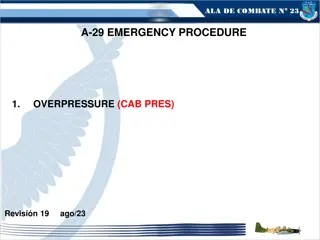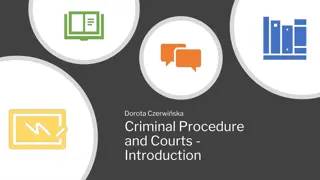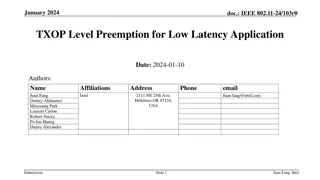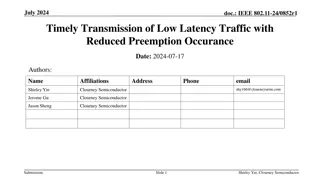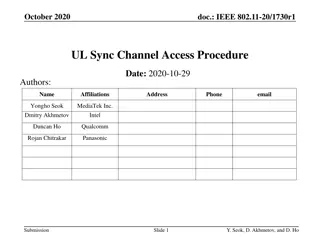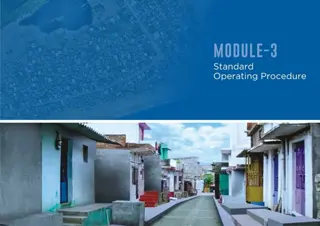Public Health’s Preemption Problem: Key Health Justice Impacts and Updates
Explore the key issues surrounding public health preemption and its implications on health justice through insights from experts like Moderator Amy Cook and Presenters Jennifer L. Piatt, Sabrina Ruchelli, Sterling Johnson, and Adam Herpolsheimer. Discover how state preemption laws can influence heal
1 views • 73 slides
Parliamentary Procedure
Learn about the role, principles, and importance of parliamentary procedure in running effective meetings. Explore the basics of Robert's Rules of Order, agenda building, the relationship between parliamentary procedure and the Brown Act, and tools for chairs to facilitate discussions and decision-m
1 views • 25 slides
Doula Billing Procedure Update for Oregon Health Plan Providers
Understand the new billing procedure for doula services under the Oregon Health Plan, including the new procedure code T1033, modifiers HD and 22, and the importance of the update. Learn about correct billing and coding, global billing examples, and different billing scenarios for doula services. Qu
2 views • 8 slides
Overview of Common Procedure for Requesting COAMU Advice
This content provides information on the common procedure for requesting COAMU advice in the Brabant Wallon, Hainaut, Namur, Liège, and Luxembourg regions. It covers topics such as the legal basis, reasons for procedure reform, principles of the new procedure, and steps for implementation. Key poin
10 views • 16 slides
TSN and Time Sensitive Wireless
This document explores the relationship between IEEE 802.11 and Time Sensitive Networking (TSN), defining TSN in the context of 802.11 and highlighting the importance of TSN for improving packet delivery, reducing latency, and enhancing network reliability. Various features like Multi-AP, preemption
6 views • 18 slides
Harvard Procedure Guidelines and Rules for Model United Nations
In this guide, you will explore the rules and procedures specific to the Harvard Procedure in Model United Nations. It covers general rules, guidelines on resolutions and voting, language requirements, courtesy expectations, rules of procedure, motions, points of order, and parliamentary inquiries.
4 views • 20 slides
Understanding Parliamentary Procedure for Effective Meetings
Parliamentary procedure is a set of rules and customs that govern meetings in various organizations. This system ensures fair and efficient decision-making by outlining the proper conduct of meetings, including making and handling motions, and the role of the presiding officer. By following parliame
0 views • 21 slides
Understanding Deadlocks in Operating Systems
Deadlocks in operating systems occur when processes hold resources and wait for others, leading to a state where none can progress. Processes may hold resources while requesting more, resulting in a standstill known as a deadlock. This deadlock arises from conditions like mutual exclusion, hold and
0 views • 25 slides
Considerations on Inter-PPDU Based Preemption Scheme in IEEE 802.11-23
In this document, considerations are presented for a preemption scheme in IEEE 802.11-23, focusing on issues such as coordination, ACK transmission timing, and channel access fairness. The proposed inter-PPDU based preemption scheme aims to improve the transmission of low latency traffics within the
1 views • 12 slides
IEEE 802.11-21/1321r1 WLAN Sensing Procedure Proposal
This document by Solomon Trainin from Qualcomm presents a proposal on aligning the SFD for the WLAN sensing procedure. It aims to resolve contradictions, optimize behavior, and introduce a structured WLAN sensing procedure. The content outlines phases, terminology, setup, measurement, and reporting
0 views • 8 slides
Understanding Timers and Interrupts in Operating Systems
This content discusses the importance of timers and interrupts in operating systems, focusing on how they facilitate preemptive multitasking. It covers how hardware timer interrupts help in preemption of processes by the kernel, ensuring efficient task scheduling and resource management in modern op
4 views • 18 slides
Tepid Sponging Procedure in Patient Care
Tepid sponging is a technique used to reduce body temperature in patients with fever. This procedure involves applying lukewarm water to the skin surface to promote heat dispersal. Key steps include preparing the patient, collecting equipment, sponging with tepid water, and monitoring the patient's
0 views • 7 slides
Worksafe Procedure NR/L2/OHS/00112 Safety Hour Overview
The Worksafe Procedure NR/L2/OHS/00112 was introduced in 2009 to empower Network Rail employees to raise safety concerns and stop work if necessary. This procedure ensures a safe work environment by allowing employees to assess risks, establish safe work practices, and receive support from managemen
0 views • 8 slides
Briefing on the Criminal Procedure Amendment Bill [B12-2021] to the Portfolio Committee on Justice and Correctional Services
The Criminal Procedure Amendment Bill aims to address the constitutional invalidity of section 154(3) of the Criminal Procedure Act by enhancing protection for child victims, accused, and witnesses in criminal proceedings. The Bill proposes prohibiting the publication of information revealing their
0 views • 12 slides
Comprehensive Traffic Management and Safety Improvement Projects
Enhancing traffic safety through advanced technology and strategic initiatives, this project encompasses various aspects from analyzing crash data to implementing systems for emergency vehicle preemption and real-time video surveillance. With a focus on reliability, transparency, and user input, the
0 views • 21 slides
Evolution of Procedural Law in Continental European Legal History
The journey of procedural law in Continental European legal history, from the challenges faced by glossators in creating Romano-canonical procedure to the discussions on canonic procedure in canon law. Explore the intricacies of legal procedure development and the influences of historical texts such
0 views • 36 slides
Lumbar Puncture: Procedure, Complications, and Clinical Applications
Lumbar puncture, also known as LP, is an invasive procedure used to obtain cerebrospinal fluid (CSF) for diagnostic and therapeutic purposes. This procedure has a long history dating back to ancient times, with modern techniques developed in the late 19th century by Heinrich Quincke. LP is crucial f
2 views • 11 slides
Lumbar Puncture: Indications, Contraindications, and Post-procedure Considerations
Lumbar puncture is a medical procedure involving the insertion of a needle into the spinal subarachnoid space to collect cerebrospinal fluid for diagnostic or therapeutic purposes. Indications for performing a lumbar puncture include suspicion of meningitis, subarachnoid hemorrhage, CNS diseases lik
0 views • 17 slides
Understanding Procedure Texts and their Structure
Procedure texts are instructional pieces of writing that explain how something works or how to perform a specific activity. They typically consist of three main definitions: texts that explain how to use something, texts that provide instructions for a particular activity, and texts that address hum
0 views • 10 slides
Update on HV Tuning Procedure for KM3NeT Group Meeting
Recap and updates on the HV tuning procedure for the KM3NeT group meeting include moving to a procedure based on gain estimates, implementing HV-fitting routines in JFitHV, and addressing issues related to linear behavior, fit ranges, and outliers. Solutions for maximizing the ToT-fits efficiency ar
0 views • 11 slides
Preemption Methods for Ultra High Reliability in Multi-AP C-TDMA
In this IEEE document, preemption methods are discussed for the coordinated time-division multiple-access (C-TDMA) scheme to enhance the Ultra High Reliability (UHR) capability in multi-AP operation. The focus is on reducing delays during large PPDU transmissions and improving coordination between s
0 views • 8 slides
Enhancing Low Latency in IEEE 802.11 Networks
Various mechanisms for low latency in IEEE 802.11 networks are discussed, including C-TDMA, C-RTWT, TXOP Preemption, and HiP-EDCA. This proposal aims to improve initial control frame exchanges to prioritize low latency traffic transmission. By modifying exchange rules and allowing STAs to signal the
0 views • 12 slides
Basis Production Procedure for AGATA through GRETINA Signal Decomposition
This presentation outlines the detailed procedure for generating basis signals in the context of AGATA data processed through GRETINA signal decomposition. It covers the generation of pristine basis signals, superpulse analysis, and the creation of cross-talk corrected basis files. The process invol
0 views • 19 slides
A-29 Emergency Landing Gear Procedure
This emergency procedure outlines steps to follow in case of low pressure in the landing gear accumulator of the A-29 aircraft. It details actions to take for the emergency gear situation, including the response for low emergency brake accumulator pressure and the procedure to follow when the landin
0 views • 4 slides
Real-Time Interrupt Handling and Scheduling in SYS/BIOS
This content covers the management of hardware and software interrupts, interrupt priorities, scheduling rules, and execution flow for real-time systems using SYS/BIOS. It discusses the handling of interrupts by the Hardware Interrupt (Hwi) and Software Interrupt (Swi) components, priority levels, p
0 views • 4 slides
Trial of Warrant Cases by Magistrates under the Code of Criminal Procedure 1973
The Code of Criminal Procedure 1973 Chapter 19 outlines the procedure for trial of warrant cases by magistrates where the prosecution presents evidence to support the case against the accused. Section 244 requires the magistrate to hear the prosecution and take all evidence presented. If the evidenc
0 views • 12 slides
Esophagostomy Surgical Procedure Overview
Esophagostomy is a surgical procedure mainly performed to address foreign bodies or esophageal diverticula in animals like horses, cattle, dogs, and cats. The operation involves accessing the esophagus, removing the foreign body, and suturing the esophageal wall. Key steps include making an incision
0 views • 14 slides
Ultra-Reliable PHY Elements: Optimized Building Blocks for Low Latency and Efficiency
The document presents a deep dive into ultra-reliable PHY elements, focusing on achieving low latency, reduced collision, and energy efficiency. It proposes optimized universal building blocks to address these goals effectively, especially in scenarios where many devices may not receive transmission
0 views • 17 slides
Project 2: Preemption in CS 4411 - Spring 2017
Project 2 focuses on addressing issues of selfish threads, starvation, and interruption handling within multi-level feedback queue scheduling. The project introduces clock interrupts, alarms, interrupt handlers, and addresses the importance of performance optimization for handling shared data struct
0 views • 19 slides
Legacy STA and OBSS Preemption Considerations in IEEE 802.11-24
Discussions in IEEE 802.11-24 address preemption issues related to UHR STAs within a single BSS, focusing on legacy STA impact and OBSS considerations. Proposed solutions aim to balance efficiency and latency by adjusting TXOP limits for different STA types.
0 views • 7 slides
Multi-AP Preemption for Low-Latency Traffic in IEEE 802.11 Networks
Discussion on the necessity of Multi-AP preemption for low-latency traffic in IEEE 802.11 networks. Addresses issues related to latency-sensitive traffic in overlapping basic service sets (OBSS). Proposes a general solution to enable OBSS APs to transmit urgent low-latency traffic without significan
0 views • 9 slides
Uniform Procedure for Preemption in IEEE 802.11-24 Standard
The presentation discusses a uniform procedure for preemption in the IEEE 802.11-24 standard, focusing on different cases where a STA preempts another's TXOP to transmit low latency (LL) traffic. It proposes a simplified design and implementation approach for handling preemptions efficiently. The pr
0 views • 12 slides
Analysis of Preemption Methods in IEEE 802.11-23/2076r3 for Latency Reduction
Discussion on preemption methods in IEEE 802.11-23/2076r3 document focusing on latency reduction objectives. Topics include coordinated preemption, random channel access, comparison between methods, and the impact on STAs performance. The document addresses concerns such as collision probability, co
0 views • 8 slides
Legal Case: Nemphos v. Nestlé - Claims Regarding Dental Fluorosis
Nestlé and Danon are facing legal action for failing to warn about the risk of dental fluorosis in their bottled waters with added fluoride, marketed as child-friendly. The case involves claims for damages related to dental fluorosis, including cosmetic repair and psychological harm. The issue of f
0 views • 14 slides
A-29 Emergency Procedure: Overpressure (CAB PRES)
An overview of the emergency procedure for overpressure (CAB PRES) in the A-29 aircraft. The procedure outlines actions to take when cockpit differential pressure exceeds 5.75 psi, including switching off the air conditioning, maintaining a maximum altitude of 25,000 ft, and following the SUPPLY FAI
0 views • 4 slides
Fundamentals of Criminal Law and Procedure
Explore the key aspects of criminal law and procedure, including definitions of crime, the role of criminal procedure, sources of law, phases of the criminal process, participants involved, and rules of evidence in legal proceedings. Gain insight into how criminal law is distinct from civil law and
0 views • 24 slides
IEEE 802.11-24/103r0 TXOP Level Preemption for Low Latency Application
This document discusses the implementation of preemption as a solution to support low latency applications in IEEE 802.11 scenarios. It focuses on dividing large PPDU into smaller ones with time gaps for preemption opportunities. The approach involves common preemption requests and triggering LL pac
0 views • 9 slides
IEEE 802.11-24/0852r1: Timely Transmission of Low Latency Traffic with Reduced Preemption Occurrence
This document discusses the challenges of ensuring timely transmission of low-latency traffic while minimizing preemption occurrences in IEEE 802.11 networks. It addresses issues related to operating modes, preemption mechanisms, and the impact on user experience. The submission proposes solutions t
0 views • 9 slides
UL Sync Channel Access Procedure in IEEE 802.11-20/1730r1
The document discusses the UL sync channel access procedure in IEEE 802.11, focusing on the conditions under which an STA affiliated with an MLD can initiate transmission, manage its backoff counter, and follow specific rules for accessing the channel. It proposes a straw poll to gather support for
0 views • 8 slides
Slum Infrastructure Upgradation Standard Operating Procedure
This standard operating procedure outlines the process for identifying, listing, and upgrading slums in Odisha. It includes steps such as Participatory Infrastructure Needs Assessment, benchmarking, I-GAP preparation, slum intervention identification, and completion of upgradation projects. The proc
0 views • 16 slides


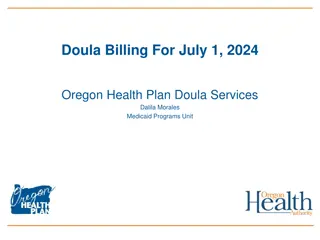

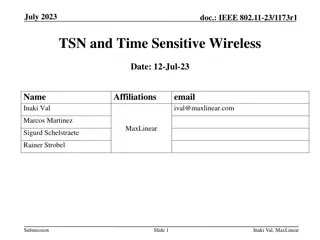

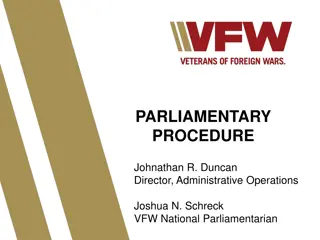

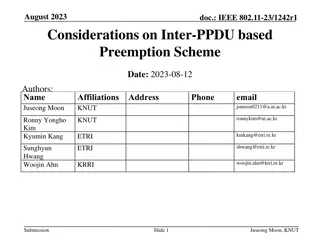

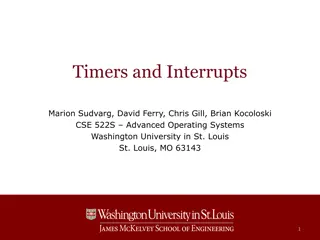
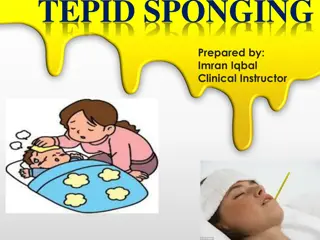
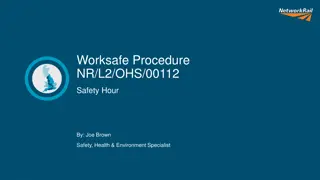
![Briefing on the Criminal Procedure Amendment Bill [B12-2021] to the Portfolio Committee on Justice and Correctional Services](/thumb/157093/briefing-on-the-criminal-procedure-amendment-bill-b12-2021-to-the-portfolio-committee-on-justice-and-correctional-services.jpg)
